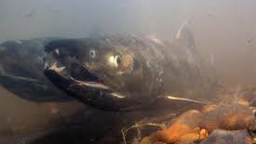Although no chum salmon have showed up yet at spawning grounds downstream of Bonneville Dam, fishery managers and dam operators agreed this week to a phased-in beginning for chum flows as a way to save Lake Roosevelt water for spring flow augmentation and to protect resident fish in the lake.
Citing dry conditions upstream at Grand Coulee Dam and low water at Bonneville Dam, Tony Norris of the Bonneville Power Administration suggested that chum flows, which usually kick off Nov. 1 each year, begin the chum operations with a lower than planned tailwater elevation at Bonneville as a way to save as much as one foot of Lake Roosevelt water and to gradually ramp up to the required tailwater elevation over a five-day stretch.
The Interagency Technical Management Team, made up of state, federal and tribal fishery managers and federal dam operators, agreed at its meeting Wednesday, Oct. 22 that the Bonneville Dam tailwater elevation would be set at 10.5 feet above sea level on Nov. 1 and ramp up to 11.3 feet by Nov. 5. The chum operations plan calls for an 11.3 foot tailwater elevation beginning Nov. 1. The current tailwater elevation below Bonneville Dam is 8.75 feet (average on Oct. 22).
So far this season, surveys of the spawning area below the dam in the Ives and Pierce Island Complex are showing no signs of live or spawning chum salmon. However, three chum have been counted crossing Bonneville Dam, all prior to Oct. 15.
“Until we get more tailwater elevation, there will not be an attraction for the fish,” said Charles Morrill of the Washington Department of Fish and Wildlife.
Norris called that an “if you build it they will come” belief, saying there would be enough of an attraction at just a 10.5 foot tailwater elevation. There is another survey Monday, Oct. 27, that could find chum moving up to spawn, he added.
Columbia River chum are listed as threatened under the federal Endangered Species Act. Many of the chum spawn downstream of the dam and are protected under NOAA Fisheries’ 2018 Columbia/Snake river biological opinion from November when they arrive to spawn through the beginning of April as fry emergence from gravel. Between those months, they are protected with minimum tailwater elevations to ensure the redds are covered by water.
And, in most years, in order to maintain chum flows, the U.S. Army Corps of Engineers, which operates Bonneville Dam, often calls on additional water from Grand Coulee Dam to augment flows and the tailwater elevation at Bonneville. The Bureau of Reclamation operates Grand Coulee.
“Reclamation supports using Lake Roosevelt water for the chum flows,” said Peter Cooper of the Bureau. “But it can have an impact on spring flows and, if the reservoir drops below 1,283 feet elevation, on resident fish.” Cooper said the phase in of tailwater elevation could save up to 2 feet in elevation at Lake Roosevelt.
Although the Columbia River basin has been dry, a storm system is expected this weekend, but Norris said he is not sure what the river response will be.
“The Willamette River and Hood River will show a response, but likely not a significant one,” he said. “It may bring the Willamette (that has been lower than normal) up to average. That’s not enough to help much with the Bonneville tailwater.”
Tailwater levels are dependent on what is available in the river, plus wind and tides (tides affect water levels all the way to the dam), and the effect of flows from the Willamette River.
NOAA’s winter outlook is forecasting below normal temperatures and above normal precipitation for December through February ( Climate Prediction Center – Seasonal Outlook), below normal temperature and above normal precipitation through Nov. 1 and la Nina conditions through February 2026.
In-flows at Bonneville, which were about 89,000 cubic feet per second on Oct. 22, are expected to rise to 115 kcfs by Nov. 2 (hydroPlot.php (700×570)).
The annual run of Columbia River chum salmon historically numbered more than 1 million fish. However, habitat loss, harvest and other factors caused their numbers to plummet during the last century to a low of just a few thousand fish returning to the river each year. An important ecological species and food for many species both aquatic and terrestrial, Columbia River chum were listed under the Endangered Species Act June 28, 2005, with a status update April 14, 2014.
Chum are the last salmon of the year to return to the Columbia to spawn, and their young are the first to leave for the ocean in the spring. Chum salmon generally spawn in the lower part of the Columbia River below Bonneville Dam in areas where warm ground water pushes up through gravel. The warm water then quickly incubates their eggs.
In October 2022, NOAA Fisheries completed its 5-year status review of four species of salmon and steelhead, including lower Columbia River chum, concluding that all the species reviewed are in as much trouble today as they were at the last status review in 2016 and should retain their current listing status (https://media.fisheries.noaa.gov/2022-10/Sign4_5-Yr_Review_LCR_FINAL_19Sep2022_SMR.pdf).
In the review, NOAA said “the collective risk” has not changed significantly and the “overall level of concern remains the same.”
For Background, see:
— CBB, March 2, 2023, Low Water, Low Flows Force Columbia River Hydro Managers To Drop Bonneville Dam Tailwater Levels Aimed At Protecting ESA-Listed Chum Salmon, Low Water, Low Flows Force Columbia River Hydro Managers To Drop Bonneville Dam Tailwater Levels Aimed At Protecting ESA-Listed Chum Salmon – Columbia Basin Bulletin
— CBB, November 3, 2022, COLUMBIA RIVER OPERATIONS MOVE TO PROTECTING ESA-LISTED LOWER RIVER CHUM SALMON; FROM A MILLION FISH DOWN TO A FEW THOUSAND,
— CBB, June 10, 2021, “A Million Chum Salmon Once Returned To Columbia River, Now Down To 20,000; WDFW Recovery Plan Aims To ‘Jump Start’ Population Rebuilding,” https://columbiabasinbulletin.org/a-million-chum-salmon-once-returned-to-columbia-river-now-down-to-20000-wdfw-recovery-plan-aims-to-jump-start-population-rebuilding/
— CBB, May 27, 2021, “Scientists Review Hatchery Programs For Recovering ESA-Listed Columbia River Chum Salmon; Supplementation, Reintroduction Priorities,” https://columbiabasinbulletin.org/scientists-review-hatchery-programs-for-recovering-esa-listed-columbia-river-chum-salmon-supplementation-reintroduction-priorities/

